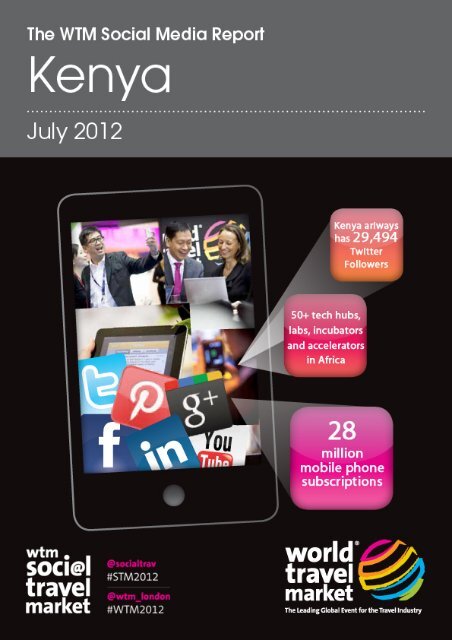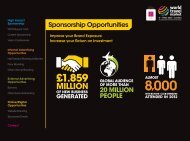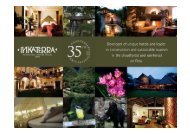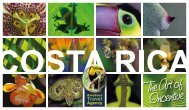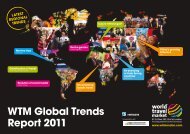Kenya gets connected - World Travel Market
Kenya gets connected - World Travel Market
Kenya gets connected - World Travel Market
Create successful ePaper yourself
Turn your PDF publications into a flip-book with our unique Google optimized e-Paper software.
KENYA OVERVIEWThis is the second in a series of social media reports broughtto you by WTM Social <strong>Travel</strong> <strong>Market</strong>.These WTM Social Media Reports provide a snapshot ofthe social media landscape in a particular country and featureinterviews with tourism and travel organisations, bloggers andothers involved in social media in travel. It has been produced by<strong>Travel</strong> Perspective (www.travelperspective.co.uk).<strong>Kenya</strong> <strong>gets</strong> <strong>connected</strong>This African nation has virtually skipped the landline and wiredinternet connection but is one of the most <strong>connected</strong> countriesanywhere thanks to strong mobile penetration<strong>Kenya</strong> is fast-emerging as theAfrican star of social mediaas growth in connectivity hasexploded.The landing of a fibre-optic sea cablethree years ago dramatically expandedthe bandwidth and broadband speedsavailable in <strong>Kenya</strong>.Coupled with ongoing investmentin Information and CommunicationTechnologies (ICT) from the governmentand <strong>World</strong> Bank, <strong>Kenya</strong> now has aleading role in African social media andIT innovation.The country ranks second only toSouth Africa for the number of Twittermessages sent, according to a recentm-Pesa handset, photo: Kiwanja.netthree-month survey by PortlandCommunications.Beatrice Karanja, head of PortlandNairobi, said: "Twitter is helping Africansto connect in new ways and swapinformation and views. And for Africa - asfor the rest of the world - that can only begood."<strong>Kenya</strong> also ranks second only - toGhana - for broadband speed on thecontinent: more than 44 per cent ofthe population now has access to theinternet, although the majority is viamobile phones.There are more than 50 tech hubs,labs, incubators and accelerators inAfrica, covering more than 20 countries– and Nairobi has six, including theinvolvement of two universities.Blogger Erik Hersman (@whiteafrican)founded the iHub in Nairobi in 2008. “Fouryears ago we built a space that now hasmore than 8,000 members and holdsapproximately 120 events per year,” hewrote in a blog. “We sit at the centre of<strong>Kenya</strong>'s tech community, where our roleis to serve as a connection point andsupport the phenomenal hi-tech growth inthe country.”2
KENYA OVERVIEWLast year, five hubs formed AfriLabs(africahubs.crowdmap.com), anumbrella body that allows investors andmedia to connect more quickly to techactivity in each of the countries with amember lab. There are now 14 membersacross 10 countries.The <strong>Kenya</strong>n government has beena supporter of the ICT community andalso pledged to improve openness andtransparency which, a year ago, saw thelaunch of an open data portal.Yet broadband usage is largelyconfined to the cities, government andbusiness. While 17.3 million <strong>Kenya</strong>nshad access to the internet at the start of2012, broadband represented just 2.1per cent of total internet subscriptions.The picture is the similar withmobile phones. The CommunicationsCommission of <strong>Kenya</strong> reports that 90per cent of the population now hasaccess to a mobile, although 99 percent are pre-paid contracts. Most arenot smartphones and have no internetaccess. Indeed, only one third of <strong>Kenya</strong>has mobile coverage.It’s why Google recently launcheda text message-based version of itsGmail service in <strong>Kenya</strong> which can runon ‘dumb phones,’ and why there havebeen several developments in this area.The ability to send from a smartphoneto an SMS service recently madeheadlines in <strong>Kenya</strong> when a chief, in avillage 100 miles from Nairobi, usedTwitter to foil a robbery.Chief Francis Kariuki got a call atnight that thieves had broken into aneighbour's house. So he tweeted on hissmartphone: "Thieves in Kelven's livingroom, let's help him out please."Subscribers got the Chief’s tweetin the form of a free SMS message:subscribers didn't need to have a Twitteraccount or an internet connection toreceive it. So a bunch of residentsturned out in the middle of the night andchased the would-be thieves out of town.Back in Nairobi, smartphone appsare also having an impact. One service- NikoHapa, Swahili for 'I am here' - letsusers check in on Facebook and Twitterusing their phones. Customers thensend a text, or scan a QR code on thereceipt, and earn loyalty points.Safaricom, <strong>Kenya</strong>’s biggest mobilecompany with two thirds of the market,is joint partner with Vodafone in M-Pesa,launched five years ago and which ischanging economies across Africa.The service allows people to pay foranything without needing cash or a bankaccount. Simply put, users pre-load theirphone by paying cash at a registeredretailer: e-float can then be swapped andtransferred between mobile users with atext message and a code.More than half of <strong>Kenya</strong>’s adults haveused it, depositing US$2bn in the finalquarter of 2011 – up 50 per cent over thesame period of the previous year.Such innovation, governmentsupport and tech development willserve the country well as broadbandand smartphone becomes morecommonplace: <strong>Kenya</strong> is well placed tolead ITC development in Africa.Google’s country manager for <strong>Kenya</strong>,Joe Mucheru (Twitter: @mucheru),cheerfully admits to poaching largenumbers of his staff from the iHub.He recently told CNN (bit.ly/OS21rA):“The children don't have the samehang-ups we had, that 'we're behind'.They think they deserve everything andshould be doing everything — that's theright attitude for young people now." @3
TRAVEL AND SOCIAL MEDIARoom for improvementVisitBritain's former head of international PR, Tess Longfield, now runsher own PR and social media consultancy in Nairobi (longfieldpr.com). She shares her view of the social media landscapeOnly a small number of tourismbusinesses in <strong>Kenya</strong> are usingsocial media effectively to market theirproducts. A large proportion of themarketplace is relying on traditionalmarketing methods to promotethemselves to a shrinking audience —and not taking advantage ofopportunities offered by Facebook,Twitter, TripAdvisor, YouTube, Pinterestand other channels.The future traveller will travel less andexpect more, therefore brands needstorytellers to sell their experiences in acrowded marketplace.<strong>Kenya</strong> has a diverse tourism offeringand visitors can access incredibleexperiences, from the unbelievablewildebeest migration in the Maasai Mara,to turtles hatching in Watamu; kitesurfingon the <strong>Kenya</strong>n coast; leopard spotting inNakuru; wild camping and some of themost luxurious safari lodges and tentedcamps in the world.Savvy brands can use social media tostand out from the crowd and tell theirstories. Whether it is updates from thebush by charismatic guides, tweeting apicture of an amazing view, a cheeryupdate on a new development,breathtaking wildlife shots on Pinterest,there are hundreds of ways tourismbrands in <strong>Kenya</strong> could communicate andreach new audiences via social media.<strong>Kenya</strong> Tourist Board recognises this4and has been making good progressboth with #Tembea<strong>Kenya</strong>, the socialmedia arm of their inititaive to tripledomestic tourism to 1.5 million domestictourists annually, and greater investmentin online marketing internationally.However, hotels, lodges, attractionsand destinations need to do the basicswell and the reality is that many <strong>Kenya</strong>ntourism businesses have not graspedthis yet. Many are floundering without astrong web presence, let alone makingthe most of the new timeline featuresand apps on Facebook.As an emerging market, <strong>Kenya</strong> hasseen rapid growth in the popularity ofFacebook and Twitter in recent yearsand the growth in social media is beingencouraged by adoption among popularmedia, celebrities and politicians.#<strong>Kenya</strong>nsonTwitter or #KOT is a vocal,influential group. Mobile usage andinnovation is high, with mobile paymentsystem M-Pesa now being copied byBarclays and other international banks.Broadband connectivity is excellent.This upsurge of tech-savvy, socialmedia evangelists and bloggers has notyet permeated to the travel and tourismsector — and there is a lot of scope fordevelopment in this area.But there are green shoots. I’ve beenworking with a new luxury hotel on thecoast, Swahili Beach, which is now usingsocial media to communicate withcurrent and potential clients.“We’ve got our Front of Housemanager re-tweeting guests who aretalking about their experiences via the(free) WiFi, our Operations Managerposts pictures of the cocktails and we’reresponding to TripAdvisor commentswithin hours of them being posted,” saysgeneral manager Tim Challen. @
KENYAN SOCIAL STARS<strong>Kenya</strong>n social starsThis table looks at the some of the leading <strong>Kenya</strong>n travel andtourism companies and their most interesting social initiatives<strong>Travel</strong> brandEcotourism <strong>Kenya</strong>www.ecotourismkenya.org<strong>Kenya</strong> Airwayswww.kenyaairways.com<strong>Kenya</strong> WildlifeServicewww.kws.orgMagical <strong>Kenya</strong>www.magicalkenya.comSerena Hotelswww.serenahotels.com<strong>Travel</strong>ing <strong>Kenya</strong>www.travelingkenya.comFacebooklikesSocial media leaders in <strong>Kenya</strong>n tourismfacebook.com/SCC<strong>Kenya</strong>twitter.com/experiencekenyafacebook.com/tribehoteltwitter.com/tribehotelkenyaTwitterfollowersYouTubeviewsSocial media standout1,096 1,217 855 Association recognises thevalue in using social media topromote responsible tourism to<strong>Kenya</strong> and is a WTMsupporting association24,054 29,494 64,366 Provides customer service topassengers via Twitter andone of the few big <strong>Kenya</strong>ncompanies with a strong socialmedia presence16,430 4,638 15,012 Making good use of own andvisitors' photos from its parks.Just started using Pinterestand running a Facebook photocompetition this year10,310 7,320 451,851 Been on YouTube for nearlyfour years and has built up agood library of strong videoclips. Also on Flickr10,444 1,461 41,741 Hotel company, best known forthe Nairobi Serena, is recruitingits first social media executive27,244 4,644 - Hugely popular travel site thatgrew out of an email newsletteramong friends and has grownusing social mediaThe Safari and Conservation Companyuses its Facebook page to communicate with fans andshare interesting stories about safaris and travel ingeneral, as well as fun updates from their properties.Chief tweeter Juliet is engaging and enthusiastic as wellas, importantly, being a real person.The Tribe HotelThis hotel projects its fashion-forward brand perfectlythrough social media channels. Its video Nairobi in a Day(bit.ly/wi35cs) is a perfect example of engaging contentcreation: it weaves the Tribe brand in but it doesn’t feelforced and shows a different side to the destination.5
CASE STUDY: KENYA WILDLIFE SERVICEIn touch with nature<strong>Kenya</strong>'s wildlife reserves are its greatest tourism asset, How is thecountry's Wildlife Service managing its social media?About eight per cent of <strong>Kenya</strong>’slandmass is protected for wildlifeand it is the job of the <strong>Kenya</strong> WildlifeService (KWS) to look after more than60 parks and reserves.There is a constant fight againstpoaching, and clashes with villagers whograze stock in reserves - only thismonth, two elephants and lions werekilled by villagers protecting their goatsand cattle.Another role is tourism promotion.Tourism is <strong>Kenya</strong>’s second largestsector, and KWS accounts for 75 percent of total tourist earnings.Kevin Madegwa, Online <strong>Market</strong>er forKWS, tells WTM about the Service’sincreasingly prominent role of socialmedia:How many staff do you have workingon social media (SM) — or do youallow all staff to post photos andcomments?I’m the person who runs KWS’s online6presence but we have five other peoplewho run SM profiles at park level. Forinstance, I managed to set up accountsfor Hell’s Gate, Lake Nakuru, SaiwaSwamp and Longonot National Parksand they are run at Park level withtourism officers.You are active on Twitter, with dailyupdates on cub births, poachingnews etc. is there a defined policy foryour Twitter feed?There’s no defined policy for what I poston Twitter but I keep it professional asmuch as I can. I had clear objectiveswhen creating and implementing a socialmedia strategy for KWS.I see KWS is also active on Facebookon the current human-wildlife conflict.Is it a policy to be 'out there' talkingon SM?We joined social media so that we couldcontribute and be part of what peoplewere saying about KWS. There’s no
CASE STUDY: WILDLIFE DIRECTpolicy like I said but we keep our onlinepresence professional.Your Facebook page also carriesstriking animal images. Do you invitepeople to send in images, or video,for use? Same for Pinterest?Most of the Facebook images are oursbut our fans usually upload amazingimages of our picturesque parks. We areplanning on doing a photo competitionon Facebook Soon. We’ve just startedon Pinterest and I am glad to say it'sworking out well.Do you have any regular engagementwith visitors to <strong>Kenya</strong> — any forums,discussions, feedback pages?Most of the engagements anddiscussions happen on Twitter andFacebook but I also contribute to postson TripAdvisor.Tell me more about Foursquarelocation-based marketing. How doesthat work? Do you use it as part ofyour operational duties?We are using location-based socialnetworks to target travellers based onwhere they are. For instance if a tourist“checks in” at Tsavo West National Park,it will be easier suggesting Tsavo Eastand Chyulu Hills National Parks as otherplaces to visitYour blog isn’t working on the KWSwebsite, plus the videos are old.What's the problem there?I have a new design for the blog and itwill soon be up and running. It’s takenages because of how government workson some things. I’m also working on aproposal on outsourcing a videographerbecause the YouTube page sucks big!Are you a leader that other nationalparks/wildlife services can learn fromin terms of social media? Do youexchange information on bestpractice with any other organisation?I’ve trained other parks on the use ofsocial media and I decide on whom torun various social profiles. I can safelysay I’m a leader. The first exchangeprogramme on social media use withother companies will be done in midAugust with Equity Bank of <strong>Kenya</strong>. @Follow <strong>Kenya</strong> Wildlife Service on Twitter@KWS<strong>Kenya</strong>An early adopterFour years ago, a number of conservationists and wildlife experts in <strong>Kenya</strong> got together tocreate a website wildlifedirect.org which, in essence, is a collection of blogs.The purpose was to give a public voice to frontline conservationists in varied fields, fromtackling poaching to saving wetlands, helping injured wildlife and work with communities.It also sought to establish a secretariat to handle donations made to the site (and its NGOparent) and redistribute to projects. As an early day use of social media, it was brilliant.Wildlifedirect.org still functions. Just. The centralised money processing has gone,however, and donations are made direct to each blogging project – US$231,000 wasdonated in 2009, mostly from North America and northern Europe.The site has 80 blogs from East Africa even though most now are rarely updated.However, a blog from <strong>Kenya</strong> in July talked of a new boardwalk being opened overmangrove swamps and progress on the Sabaki River Conservation Area. If you’re lookingto research, it’s still worth an hour of your time.7
THE BLOGGER VIEW"Embrace social media"Njoroge Nguru (@njooro) is co-founder of e<strong>Travel</strong> <strong>Kenya</strong> inMombasa, which oversees e-marketing operations for various clients.He is also a part-time geek at www.kenyatweets.comvocal in creating awareness aboutpoaching and wildlife conservancy usingsocial media. Their focus onconservancy issues while still marketingstands out from the rest of the players.How long have you been bloggingabout tech and travel in <strong>Kenya</strong>?Seven years but only the last four ontech and travel. I got tired of bloggingjust for the traffic and decided to pick upniches that I could make money from.<strong>Travel</strong> was easy for me to choosebecause I like to travel and tourism is<strong>Kenya</strong>'s biggest earner. I blog about techto keep in touch with the changinglandscape: there is a lot of innovationgoing on in <strong>Kenya</strong>.How advanced is the <strong>Kenya</strong> travelindustry in using social media?Sadly, the travel industry lags behind.The major travel companies are almostnon-existent on Twitter and Facebookand only the small ones and startups arereally having a go at social media. Thismay be because the industry is stillcontrolled by the 'older folks'.Any examples of social media bestpractice in <strong>Kenya</strong> tourism?The <strong>Kenya</strong> Tourism Board used Twitteras part of its Tembea <strong>Kenya</strong> domestictourism campaign, creating the#tembeakenya hashtag for people touse to talk about their travels around<strong>Kenya</strong>. A year on, people are still usingthe hashtag whenever they travel tovarious destinations in <strong>Kenya</strong>.Ol Pejeta (www.olpejetaconservancy.org) is one of the biggest rhinosanctuaries in <strong>Kenya</strong> and has been very8Is the growth of social media in<strong>Kenya</strong> all via mobile, or is use oflaptops still growing?Most of the social media activity iscertainly via mobile, it explains why<strong>Kenya</strong>ns on Twitter (#KOT) is such anactive group. The use of mobiles hasactually helped drive the sales of PCs asmost <strong>Kenya</strong>ns are introduced to internetvia the phone and the next step for themis usually a netbook/laptop/PC.Is there much growth in appsdeveloped by <strong>Kenya</strong>ns for <strong>Kenya</strong>ns?There are apps for farmers, teachers,medics but none for travellers or thoseseeking information on <strong>Kenya</strong>ndestinations. I think this is because localdemand remains low with most of thetourism money coming from Europe. Iexpect things to change as the <strong>Kenya</strong>nmiddle class grows.Any examples of good social mediause in the safari industry?Safari people are just not very good withsocial media. Uniglobe <strong>Kenya</strong> (www.uniglobeletsgotravel.com) has beenconsistent and one of the betterexamples for others to follow. They seemto have a lot of conversations with theirclients on social media.Any other thoughts or comments?Use of social media will grow as morepeople get online. The travel industry willbe forced to embrace social media as achannel in order to remain relevant. @
SAFARI LODGESOne lodge's social journeyThe most famous of the many lodges in <strong>Kenya</strong>, Governors is wellused to media exposure, having played host to several TV seriesincluding Big Cat Diary, Planet Earth Live and Safari Kitchen.Created in the Mara 40 years ago bysafari pioneer Aris Grammaticus,Governors has grown to become acollection of seven camps and lodges.He died last year and his eldest son,Dominic, is now managing director.But Aris’s daughter, Ariana, is in chargeof online activity for the camps, havingreturned to <strong>Kenya</strong> in 2007 after workingin travel in the UK.On taking stock, she relaunched thewebsite (governorscamp.com) thisyear, with Twitter and Facebook plug-inson the home page and links to YouTubeand blogs.But a paucity of recent content isexplained by the camps coming in tohigh season – the wildebeest migrationis on the move – and the birth of hersecond child in June.“It’s only me and one other on socialmedia – and he’s away for a month inCambodia,” she said in a call toGovernors recently.Like so many camps in <strong>Kenya</strong>,Governors' social media channels arestrong on images. They include shots ofa mother’s last cheetah cub (pictured)and a lion fight – each received morethan 100 likes on Facebook.The regular feed of news is welcomedby Governors’ clients, many of whompost photos and know the individualanimals concerned – the camps have astrong repeat business. “It is a way ofkeeping in touch with what is happeningin our camps,” says Ariana.But surprisingly, no Pinterest or videos– wildlife or otherwise – have beenloaded onto Governors’ YouTubechannel since October 2010. Arianaadds: “Clients don’t tend to upload themand it does take time for us – we aremostly looking after clients.”The time element is something socialmedia managers will sympathise with.Ariana runs four blogs, the main onecovering the Maasai Mara and others forlodges in the Rift Valley, Lake Victoriaand Rwanda.Postings have been sporadic since theBBC were last there, in May, but theblogs do address smaller fauna, such asbutterflies and birds, while a monthlygame report gives exhaustive detail ofgame and weather.Mapping is something Ariana isinterested in since one appearedrecently showing the migration(facebook.com/maasaimarakenya).While a static map, collated fromdifferent sources, the potential forshowing live data and images of thewildebeest is clearly attractive. “It is –but we have to be careful: you don’twant to take away the magic of being onsafari and discovering somethingunexpected.”Ariana is planning the company’s 40thanniversary in November. Is sheplanning to ask clients for their oldimages and video to incorporate into afilm, book or microsite, we ask?“It’s one of the ideas we’re kickingaround,” she says. “Some clients havebeen coming here for 40 years. They’vegot a lot of social media.” @9Photo: Governor's Camp Collection


